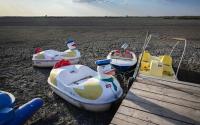21 May 2006Chad Heeter
Let me see if I have this straight. The U.S. has just experienced the warmest April in recorded history. In the meantime, down on the Gulf Coast where, since 1995, water temperatures (and severe storms) have been on the rise, all signs "point to a prolonged period," lasting at least 15-20 years, "of more frequent and more intense hurricanes" -- and this news comes not from some far-out environmental group, but from Oil & Gas Journal. After all, in 2004/2005, the region experienced three of the most severe hurricanes in the last hundred years -- Ivan, Katrina, and Rita -- all unusual in their ferocity and the size of their areas of impact. And how prepared are the Americans of our southeastern coast for a repeat in 2006?
Chad Heeter, a former student of mine -- he previously wrote My Saudi Arabian Breakfast for this site -- recently visited the forlorn Mississippi coast where Katrina smashed ashore almost nine months ago. He offers a striking tale of how FEMA has "prepared" Mississippians for only the best possible weather outcomes in 2006. Maybe, given the situation, it's time for the President to strike preemptively and call in the only institution in which he has the slightest faith, the military, before the first storm hits. Or maybe he should follow up his Mexican border initiative and put in yet another emergency call to the major corporations of the Military-Industrial Complex with a request that they transfer some of their "high-priced, high-tech tools" at work in Afghanistan and Iraq to the southeastern sector of the Homeland. Maybe, they could extend the electronic wall (or "virtual fence") planned for the Mexican border eastward and lock out those foreign hurricanes. Okay, it didn't work in Vietnam (but who remembers the "McNamara line," named after Secretary of Defense Robert McNamara, these days?); it won't work on the Mexican border (where, when it came to the last high-tech enforcement system, "nearly half of 489 remote video surveillance sites... were never installed; sixty percent of sensor alerts are never investigated, 90 percent of the rest are false alarms and only 1 percent overall result in arrests"), no matter how many unmanned aerial vehicles we put into the skies over El Paso; but in Mississippi, who knows? Tom
FEMA's Flying Tuna Cans
The New Hurricane Season on the Mississippi CoastBy Chad HeeterI'm standing on the coast, staring not at the Gulf of Mexico but inland, into the nothingness that used to be Waveland, Mississippi. Where once homes, a library, and the city hall stood, there's only rubble, ghostly slabs of concrete, sun-bleached pants, nightgowns, and curtains eerily draped high in the trees, and a single, green minivan crumpled like an aluminum can. Oh yes, and then there are the "travel trailers" -- FEMA supplied -- that sit on the tombstone-like slabs and house many of the residents who remain in this small seaside town.
Now, your basic travel trailer is great for a family vacation to Yellowstone, but as protection against a storm? Even when tethered to the ground (and some of these aren't), trailers can rock back and forth in relatively mild winds and be heavily damaged in your ordinary thunderstorm. But here in Waveland, where Katrina hit with devastating Category-4 force nine months ago, and far more important, less than two weeks before the next hurricane season revs up on June 1st, these trailers shelter hundreds of families. In fact, over 90,000 Katrina families scattered across Louisiana, Mississippi, and Alabama now sleep in FEMA trailers and are likely to face, in the months to come, a new danger on the unreconstructed coastline of the southeast – that, in a storm much kinder than Katrina, their "homes" will be turned into flying tuna cans.
In October 2004, experts at the American Meteorological Society, considering mobile home communities, issued a report which concluded in part: "The public perception that only tornadoes and hurricanes destroy mobile homes is wrong. These homes can be demolished by many kinds of severe winds." In fact, according to the National Oceanic and Atmospheric Administration (NOAA), nearly half of the deaths caused by tornadoes in the U.S. come when trailer residents either stay put to ride out the storm or flee in areas without immediately available shelters. Forget hurricanes, Mississippi is hit with an average of 24 tornadoes a year and already ranks second in the nation in the number of tornado-related deaths and injuries.
Gusts of 50 miles per hour lasting more than three seconds can damage mobile homes. From March 2003 to April 2005, thirteen storms with winds of at least 58 mph -- the low-end of a severe storm -- blew through Waveland and surrounding communities according NOAA's online database. At that strength, such a storm wouldn't even qualify as a Category-1 Hurricane.
Having put over 100,000 Mississippi residents in 38,000 trailers, how has FEMA addressed this issue? Its website essentially dumps the problem in the laps of the trailerized, suggesting that it's their responsibility to closely monitor weather patterns, as in the event of a tropical storm or a Category-1 hurricane they would have to be the first -- in some cases, the only people -- to evacuate. Oh, and they'll need to leave the trailers behind. It's illegal to move the FEMA trailers.
Under hurricane conditions, the website points out, "such shelters are particularly hazardous...no matter how well fastened to the ground." A chart on the same web-page makes the dangers vividly clear. A Category-2 hurricane will simply destroy all mobile homes in its path.
FEMA suggests that, on recognizing the signs of an oncoming storm, trailer residents should head for the nearest storm shelter. One problem: there is only one certified Red Cross shelter in Hancock County, 20 minutes inland from the trailer communities in Waveland, and that shelter has a scanty capacity of just 250 people. (The current estimated population of Hancock County is over 40,000 people.) Of course, such shelters, essentially reinforced concrete bunkers, could be built right in these trailer communities, but don't count on that happening in the brief days before the next storm season gears up to rush across the overheated waters of the Gulf of Mexico.
If not sturdy homes or storm shelters, what has been rebuilt along the coast? Casinos and fast-food restaurants. These went up in the blink of an eye and have been operating at peak capacity for many months -- and this is a good thing. These businesses employ thousands of locals and generate much-needed revenue for cities like Biloxi and Gulfport. But the employees working in housekeeping at Biloxi's Imperial Palace Casino, or taking drive-thru orders at the Wendy's in Waveland, are low-wage earners. What do they live in? Many in those trailers, of course. Will local officials or FEMA bureaucrats be organizing ways for them to leave the area with each threat of a tropical storm, of which there could be dozens?
In January, the Mississippi Emergency Management Agency (MEMA) announced a $6.6 million reimbursement program to encourage communities and families to build storm shelters or in-home "safe rooms" in the event of extreme winds. But at most this funding will subsidize shelter construction for only a few thousand families -- and if you live in a low-lying flood zone like Waveland, you won't qualify for the grant.
It seems that what FEMA has created is an illusion of safety. Because these families have been placed in temporary housing, are we assuming they'll safely ride out the next storm season?
With the 2006 hurricane season promising to be as active as last year's, maybe this is the summer for FEMA to pack up those trailers and organize caravans of Mississippians to take that long-awaited trip to Yellowstone.
Chad Heeter is a writer from Lee's Summit, Mo. He lived in a travel trailer for three months one summer during college.






